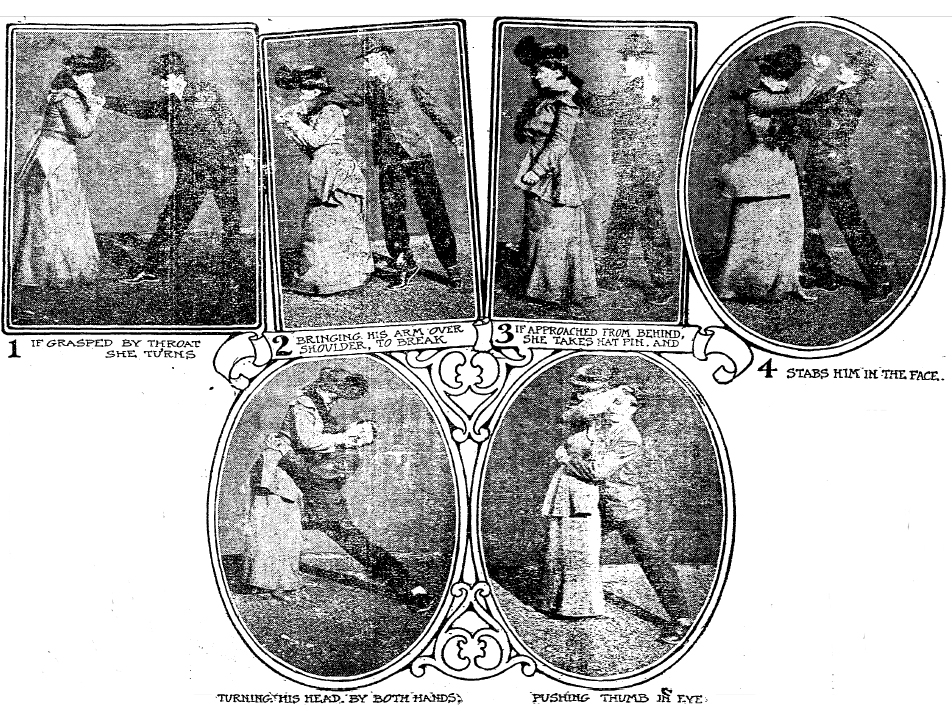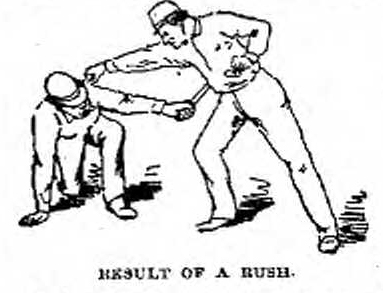- Originally published on the Bartitsu.org site on Friday, 26th April 2013
Thanks to Maxime Chouinard for locating and forwarding this fascinating, unique technical account of close-combat instruction with the famous Bowie knife. The article transcribed here was originally published in the “St.Louis Republic” of June 14th, 1890; it was evidently heavily based on an earlier article published in the San Francisco Examiner.
The subject of the article, Louis Juan Ohnimus was born in Scranton, Pennsylvania on October 27, 1857. His family had moved to California when he was twelve years old. By circa 1880 Ohnimus had taken up a position as the Superintendant of Woodward’s Gardens, a large botanical garden/zoo/museum/amusement park complex in San Francisco’s Mission District. He had the reputation of being an athletic outdoorsman and animal-catcher with years of experience in the wilderness, and also seems to have been considered a local authority in exotic weaponry; another San Francisco Examiner article details his expertise with the riata (lariat).
After Woodward’s Gardens closed in 1891, Ohnimus became the President of the San Francisco Civil Service Commission, a position he held until his untimely death due to pneumonia on April 2, 1903.
SIX INCHES OF STEEL
Deadly Accuracy of a Bowie Knife in a Hand-to-Hand Conflict
A Weapon that Never Misses Fire if You Know How to Use It
How to Avoid a Fatal Thrust
In a dusty corner of the office at Woodward’s Gardens, says the San Francisco Examiner, hangs an old bowie knife. The blade is long and heavy and the rough handle is weighted to balance it. It has been there for years and years, and if there is any story connected with it, it has been forgotten long ago.
A reporter, looking at the old relic, suggested that the time for such weapons had passed.
“That wouldn’t be of much use in these days of double-action six-shooters, would it?” said the newspaper man. “Another thing is that there is little to be learned about handling a knife. Men are pretty nearly equal when you put a knife in the hand of each.”
“I don’t know about that,” said Mr. Ohnimus. “More men carry knives than you think, and I know of those who, at a distance inside of twenty feet, could best any man, except an expert, with a pistol, and even the expert would find it hard work to get away with them. As to the question of skill, there is a great difference between men in handling knives as there is in fencing. You can judge how skilful men may become when you know that some of the celebrated knife duels lasted for hours – and the men trying to cut each other all the time – before one went under. I’m not an expert, but if you like, I’ll show you a little of the science of the knife.
The first thing, of course, is to have a knife you can depend on. It must be just the right weight, perfectly balanced, slender enough to penetrate easily and yet so strong as to go through an inch board without breaking. Such a knife is easily worth $40 or $50, and no gold or silver filigree on it, either.”
“A double edge is the best, isn’t it?”
“Not to my notion. I’ll show you why.”
He produced a couple of common knives, one double-edged and one bowie.
“Now, lunge at me,” said Mr. Ohnimus. The newspaper man, with the two-edged weapon, did as he was bid.
Cling!
The two knives rung together, edge to edge. They cut a notch in each other that locked them fast.
“Now, I’ll thrust, and you try the same thing.”
When the bowie came the other knife went down on its smooth back. The edge of the dagger was dented again, but it slipped right off the Bowie.
“You hold your knife like the stage avengers,” said Ohnimus. “That’s wrong for half a dozen reasons. You should take it just as you would a sword. In the first place, you lose reach, and in the second place, if I can grab your wrist or get my hand over yours, you are helpless, and if I am strong enough I can force your hand down and stab you with your own knife. That’s the way Porfirio Gomez killed an Italian gambler at Culebra Pass. Gomez was entirely unarmed, and the faro-dealer came for him. The Mexican was very strong and as quick as a cat, and before the Italian knew what was up, his knife, with his own hand still grasping the handle, was into him up to the hilt.
Besides, you can’t throw a knife from that position, and in a row you always want to be ready to do that. Another thing you must not do is wave your knife or fence like you would do with a sword. Move your hand as much or as quickly as you please, but keep the point directly toward your adversary. The Mexicans, and I guess they know more about handling knives than any other people on earth, keep the point directly toward the other man’s eyes. They keep it circling about like a flash of fire, compelling the other man to keep his eyes on it. They work around quicker and quicker until they see a chance, and then down goes the knife quicker than the eye can follow it.”
“Yes, but if I keep my knife ready, how can you help running on to it?”
“Well, just try and I’ll show you.”
The two took their positions with wooden knives and Ohnimus’ knife point began to dance before the reporter’s eyes. A few seconds of this during which Ohnimus constantly shifted his position, then the man who understood knives dashed his hat into his opponent’s face and at the same instant brought his knife against his breast.
“That is an old trick,” he said. “A man must do it awful quick. His adversary must not see his hand move to his hat. That hand must go even faster than the one that holds the knife.”
“How would you avoid that if someone tried it on you?”
“By jumping sideways, backward or dodging. Fighting with knives is like boxing and everything else. Every attack has its defense, but the quickest and coolest man can, of course, sometimes get in a thrust even if the other man knows how it ought to be stopped – like La Blanche’s swing that knocked Dempsey out. I remember a case. Lightning Jake was about as good a knifeman as I ever saw. He beat numbers of great fighters. Well, one day a young fellow got into a dispute with him, and both drew their knives. Jake had fought so many good men that he was always looking for fancy work and the young fellow poked out like a farmer and got him.
Now I’ll show you how to meet a thrust. Let drive!”
Out went the reporter’s blade.
Ohnimus caught his arm on his knife, and with the left hand knocked the blow down, and the reporter’s weapon flew to the ground.
“That would have disabled your fighting arm,” said Ohnimus, “besides disarming you. Another way of stopping that down thrust is this.” This time, just as the blade touched Ohnimus’ body, he brought his own down full on the other’s wrist. Almost the same moment, he struck the back of his own blade heavily with his left hand.
“That would come pretty near cutting off your hand,” he said.
“Probably a safer way than either,” he resumed, “is simply to catch you about the biceps muscles when you strike. That will stop you quick enough.”
“Well, how would you get the thrust in?”
“I would try to get so low that you could not reach me.”
“Well, if I did that, how would you avoid it?”
“I’d simply drop to the floor, and then you could not get under my guard. As you see, there is a way to stop everything, and the quickest man wins. You keep your man’s eyes on the point of your knife, and then you have to decide how to fight. You may be able to run past him on one side, and stick your knife into his side as you go.
Twisting Dan’s best trick was a good one. He would dodge around his man, suddenly grab his knife arm by the elbow, twist him around with the jerk and stab him in the back. He made a grab at a slippery little chap once, though, and missed the elbow, and his friends buried him right there.
A favorite attack is to catch your adversary’s arm between your arm and your body, and while you pinion him in this shape, drive your knife in between his shoulder blades. You usually aim for his neck or the armpit nearest you, where there are no bones to interfere. The stomach is, of course, the best place to reach a man to end him, but you want to keep as far from your adversary as possible, so you aim for the nearest spot.
Another trick that has caught many a good man is this: you retreat before your adversary’s attack, and at last start to run. If he runs after you, you increase your pace until your are sure he cannot stop. Then you drop directly in his path and either hold your knife so he will run into it or let him fall over you and, as he turns, stab him in the back.”
Getting down onto the floor is a pretty safe thing to do in a knife fight of you are on the defensive. You can pivot on one knee, and a cool man with a knife in that position is awful hard to get at. The only thing to do is to get down, too, and fight it out on the ground.”
“You spoke of a knife against a revolver. Do you mean to say you could get away with me if I wanted to shoot you?”
“Try it,” said Ohnimus.
The reporter strapped on a revolver.
“Now, draw and snap it,” taking a position over ten feet away.
Almost before the pistol was out of the scabbard, Ohnimus’ knife struck gently on the reporter’s armpit. Before the trigger was pulled, Ohnimus had caught the pistol and thrown it up.
“It is not much of a trick to throw a knife, but it is dangerous. You part with your weapon and if you don’t win on the one throw you are gone. Still, in many cases that it the only chance, and it has won lots of times.
There is a Mexican over in San Quentin now who killed two men by throwing his knife. One came for him with a pistol and the other had a Winchester rifle.”
“A rifle!”
“Oh, yes. That is easier to beat with a knife than a pistol at close range. In a room, for instance, an expert with a knife would have an advantage of a man with a rifle. A quick man would not even have to throw his knife. Before the fellow with the rifle would aim and fire, he could dodge and come up under the rifle barrel and throw it up.
Don’t let anybody tell you that the knife is no good. A clever man will do more with it than with a pistol, and it never misses fire.”




















